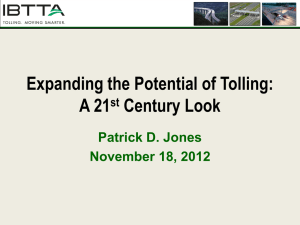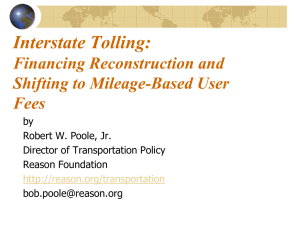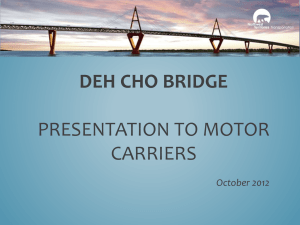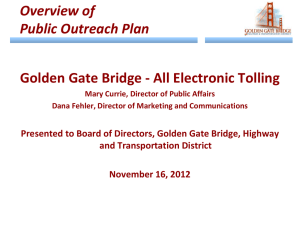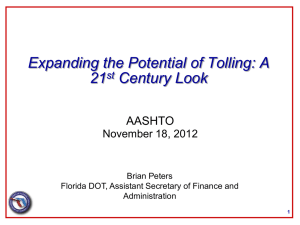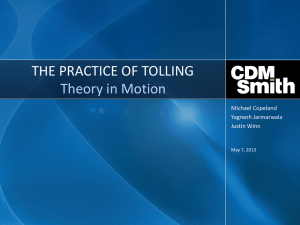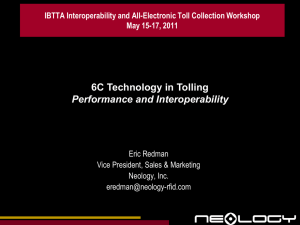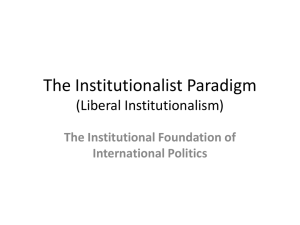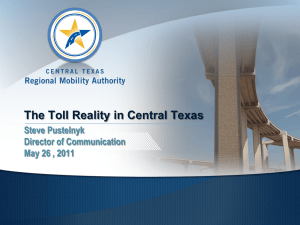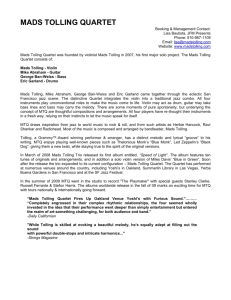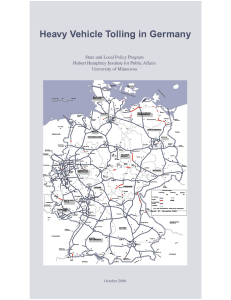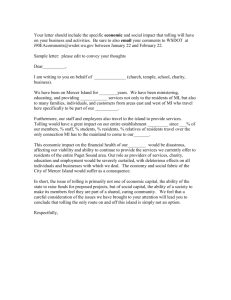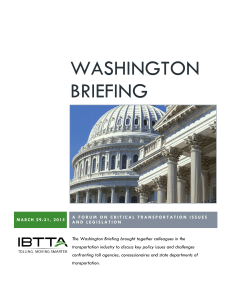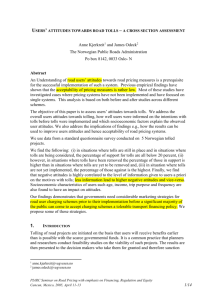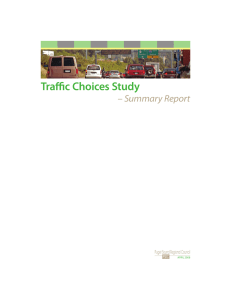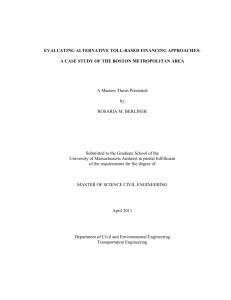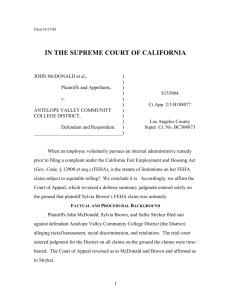Interstate 2.0: a 21st-Century Network Financed by All
advertisement
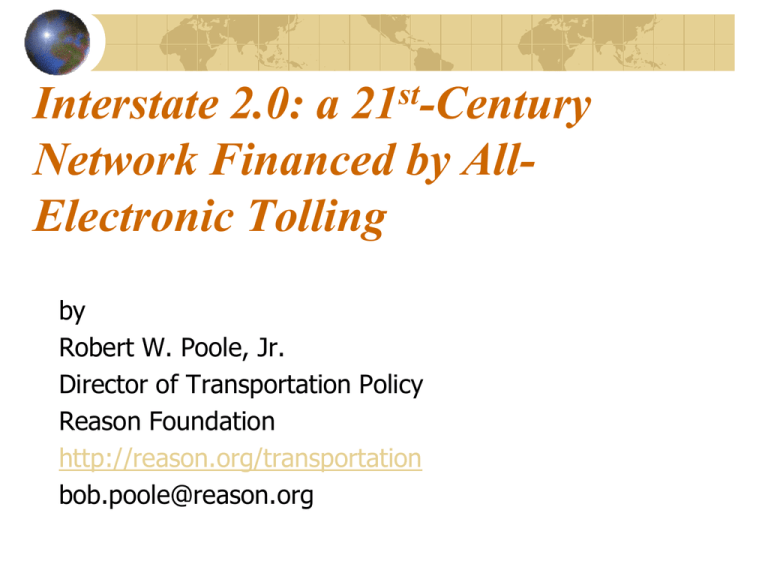
Interstate 2.0: a 21st-Century Network Financed by AllElectronic Tolling by Robert W. Poole, Jr. Director of Transportation Policy Reason Foundation http://reason.org/transportation bob.poole@reason.org Rationale for the study America’s most important highway infrastructure: 25% of miles traveled on just 2.5% of all lane-miles; Nearing the end of its 50-year design life; Many corridors need widening; Many designs are obsolete, especially major interchanges; Map reflects America of the 1950s, not of 21st century. Purpose of the study: Estimate cost of reconstructing entire Interstate system; Estimate cost of needed lane additions, including truck-only lanes; Assess the feasibility of financing this project via all-electronic tolling (AET). Why consider toll finance now? Vastly more traffic than when tolling rejected in 1950s; Major national trucking industry; South and West far more developed than in 1950s; AET greatly reduces toll collection cost; Global capital available to invest in such infrastructure. Methodology Use state-specific FHWA data; Estimate costs state by state, for reconstruction and widening; Use FAF data for truck-lanes analysis; Use same toll rates everywhere, as baseline, CPI-adjusted; Use moderate congestion pricing for urban Interstates; Basic feasibility: NPV revenue/NPV cost. Toll revenues Each state, rural and urban separately VMT growth rate estimates for each state, for cars and for trucks (Volpe Center) 30-year VMT and revenue projection for each state. Rural: 3.5¢/mi cars, 14¢/mi trucks; CPI-adjusted Urban: moderate peak/off-peak tolls, for each of four urban size categories Net revenue=85% of gross (10% for O&M, 5% for AET collection costs) Results of reconstruction analysis NPV of net revenue exceeds NPV of reconstruction cost in most states. But—some of that revenue is based on VMT beyond what specific corridors can handle at current size. Hence, next step assessed widening needs. Widening methodology Need to analyze each Interstate separately. FHWA provided data on rt-mi and ln-mi for each route, by state. Used VMT projections to estimate DVMT/lnmi for each: 2010, 2020, 2030, 2040. Used LOS C as standard for rural: 96 routes need lane additions. Used LOS D for urban: 97 need lane additions. Truck-only lanes Separate data set from FAF on truck volumes, by Interstate route, by state. Truck VMT for 2007 and 2040, based on FAF modeling. Computed 2040 truck DVMT/ln-mi for all longdistance corridors, compared with previous (non-FAF) 2040 projection. Result: 29 corridors with 40% or more truck traffic in 2040—some exceeding 100%. Overall widening cost about $500B. Overall results NPV of cost = $1 trillion. Overall NPV of revenue = 99% of NPV cost. 30 states positive with basic toll rates, of which 9 could do it with lower rates. 9 states need slightly higher rates 6 urban states need even higher rates. 6 rural states need higher rates and/or supplemental funding. Four major implications Compared with 50 years ago, a very positive result. Large majority of states could do this on their own. Big constraint is federal ban on tolling “existing” lanes—but these lanes won’t be there unless reconstructed. Could be first major shift from fuel taxes to mileage-based user fees. Value-Added Tolling Better service (LOS) than today. Begin tolling a corridor only after it is modernized. Use toll revenues only for Interstate modernization (true user fee). Tolls would replace fuel taxes on tolled corridors. Toll rates much lower than on new toll roads (much greater volume). Political feasibility? Survey data shows tolling preferable to increased taxes for major highway improvements. Value Added Tolling is user-friendly. No serious alternative is available for a trillion-dollar 21st-century Interstate system. Key change would be federal permission—let states make the case to their voters. Conclusions Interstate modernization is mostly tollfeasible. Value-added tolling could be key to political feasibility. Federal role to be determined. First step: federal permission for all states (mainstream the pilot program). Questions? Contact information: http://reason.org/transportation Bob.poole@reason.org Lower-cost, lower-toll states AL, AR, IL, LA, MS, OK, SC, TN, UT Could do it with less than baseline rates of 3.5¢/mi car and 14¢/mi truck. Estimated range: Cars 2.1 - 2.7¢/mi Trucks 8.3 - 11.2¢/mi Higher cost, higher-toll states CA, DC, MA, NJ, NY, WA Range for cars: 5.2 - 7.7¢/mi Range for trucks: 21 - 31¢/mi Compare current rates in Illinois: Cars: 2.2 - 6.2¢/mi Trucks: 22 - 49¢/mi Difficult rural states Low traffic and costly, mountainous terrain AK, MT, ND, SD, VT, WY Except for Alaska: Cars: 5.5 - 9.8¢/mi Trucks: 22 - 39¢/mi Alaska not toll feasible (only 24% of costs covered)
